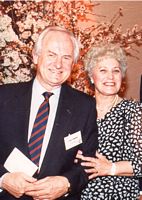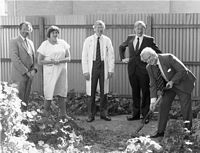


The development of microvascular surgery in Australia
Introduction
Participants
Beginnings
Developing links with academia and hospital medicine
A bevy of supporters
An ever-widening circle of contributors
Building research capacity
Nurturing relationships
Raising funds for research and development
The microsurgeon and the law
Winning community and corporate support
Leadership
The Institute and its style
Endnotes
Index
Search
Help
Contact us

Laurie Muir: [7] I assume it was after Mass.
Joan O'Brien: [8] Yes, yes it was.
Laurie Muir: It was usually about 11 o'clock.
I first met Bernard[9] on the football field, Xavier playing Scotch. Two years running we defeated Xavier. He was a tenacious little rover as many of you know. He was tenacious in everything, doggedly determined. And his vision and determination are why we're here today.
At quite an early stage – I think it was about 1968 – we had an informal discussion with Sir William Kilpatrick[10], I think it was, and then some informal meetings. The early players were two great doctors from the hospital – Mr Henderson[11] and John Connell[12] - as well as Gerard Crock[13] right from the start. This was a nice cross section because it brought ophthalmology into the mix.[14]
Quite early, he [Bernard] used to tell me about this young protégé he had. One day I met Wayne [Professor Wayne Morrison][15] and he looked like a boy. He said from the outset, and Bernie didn't easily admit these things, he said “Wayne is much better than I am at this skillful microsurgical work”.
Bernard concentrated very powerfully on the hand. He liked to be known as a hand surgeon and I think he was our foremost hand surgeon. His ability to work night and day was incredible. He wrote many books that were so detailed I could never understand them.
Joan and I held his hand some of the time and we . . .

Bernard and Joan O’Brien. Used with the permission of the Bernard O’Brien Institute of Microsurgery.
Laurie Muir: It was the determination to get this thing [the Microsurgery Foundation and Microsurgery Unit] off the ground that I most remember about Bernard, and his influence over others. He couldn't understand the Sisters of Charity.[16] They are the most wonderful ladies and I used to keep telling him that. Noble ladies. But they frustrated him because they wouldn’t do his bidding in the way he wanted it done. He was impatient in the end about that. We had much sorting out to do. Fortunately the hospital also had some great outside guidance from Barry O’Callaghan[17] and Phil Spry-Bailey,[18] who’s here. Phil helped me sort out a few issues over the years. But Bernard wanted above all to have a building; he wanted to have a truly world professional research centre. Personally, I’ve always got most pride from the way he trained people from all over the world. We used to have an old photograph gallery, and I do encourage you all to have a look at that because it was a great achievement.
The first building was only a million dollar affair but the phone calls used to come pretty regularly over that period. 'When are you going to get me my money? How are you going? And have you thought of this, and this, and this?' One day, he rang and said, 'Look, you’re so close that I’m going to start the building’. He had obviously straightened out some issues with the Sisters. And then on another occasion, he rang me and said, 'Look, we’re going so well with the building, I’ve already arranged for the Archbishop to come and open it. So you’d better make sure you’ve got the rest of the money in the bank by such and such a day.’ That was Bernard, a great driver.

Bernard O’Brien turns the first sod of new microsurgery building in 1983. Dr Keith Henderson is immediately behind him. Used with the permission of the Bernard O’Brien Institute of Microsurgery.
He was very ably supported by Wayne and his fellow surgeons, and by some very noble people who joined our board in the 1970s and the 1980s. Probably the best workhorse and my best contribution to the Foundation was getting Tony Charlton[19] on board. Tony is a man of his word, he has vision and ideas and he was probably our most successful event organiser and fund raiser.
Perhaps that's enough for me for the opening. But I would say we honour Bernard O’Brien today. The Institute wouldn’t have happened without him, and the brilliance of those who have followed him. It is a world-renowned institution now and I’m very proud to be its patron.
 |
Witness to the History of Australian Medicine |  |
© The University of Melbourne 2005-16
Published by eScholarship Research Centre, using the Web Academic Resource Publisher
http://witness.esrc.unimelb.edu.au/041.html